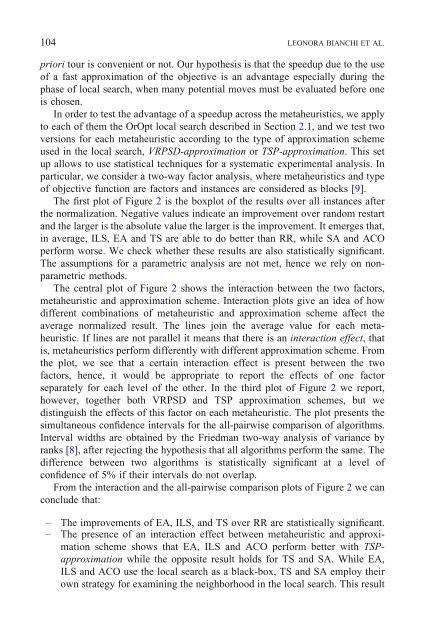Hybrid Metaheuristics for the Vehicle Routing Problem with ...
Hybrid Metaheuristics for the Vehicle Routing Problem with ...
Hybrid Metaheuristics for the Vehicle Routing Problem with ...
You also want an ePaper? Increase the reach of your titles
YUMPU automatically turns print PDFs into web optimized ePapers that Google loves.
104 LEONORA BIANCHI ET AL.<br />
priori tour is convenient or not. Our hypo<strong>the</strong>sis is that <strong>the</strong> speedup due to <strong>the</strong> use<br />
of a fast approximation of <strong>the</strong> objective is an advantage especially during <strong>the</strong><br />
phase of local search, when many potential moves must be evaluated be<strong>for</strong>e one<br />
is chosen.<br />
In order to test <strong>the</strong> advantage of a speedup across <strong>the</strong> metaheuristics, we apply<br />
to each of <strong>the</strong>m <strong>the</strong> OrOpt local search described in Section 2.1, and we test two<br />
versions <strong>for</strong> each metaheuristic according to <strong>the</strong> type of approximation scheme<br />
used in <strong>the</strong> local search, VRPSD-approximation or TSP-approximation. This set<br />
up allows to use statistical techniques <strong>for</strong> a systematic experimental analysis. In<br />
particular, we consider a two-way factor analysis, where metaheuristics and type<br />
of objective function are factors and instances are considered as blocks [9].<br />
The first plot of Figure 2 is <strong>the</strong> boxplot of <strong>the</strong> results over all instances after<br />
<strong>the</strong> normalization. Negative values indicate an improvement over random restart<br />
and <strong>the</strong> larger is <strong>the</strong> absolute value <strong>the</strong> larger is <strong>the</strong> improvement. It emerges that,<br />
in average, ILS, EA and TS are able to do better than RR, while SA and ACO<br />
per<strong>for</strong>m worse. We check whe<strong>the</strong>r <strong>the</strong>se results are also statistically significant.<br />
The assumptions <strong>for</strong> a parametric analysis are not met, hence we rely on nonparametric<br />
methods.<br />
The central plot of Figure 2 shows <strong>the</strong> interaction between <strong>the</strong> two factors,<br />
metaheuristic and approximation scheme. Interaction plots give an idea of how<br />
different combinations of metaheuristic and approximation scheme affect <strong>the</strong><br />
average normalized result. The lines join <strong>the</strong> average value <strong>for</strong> each metaheuristic.<br />
If lines are not parallel it means that <strong>the</strong>re is an interaction effect, that<br />
is, metaheuristics per<strong>for</strong>m differently <strong>with</strong> different approximation scheme. From<br />
<strong>the</strong> plot, we see that a certain interaction effect is present between <strong>the</strong> two<br />
factors, hence, it would be appropriate to report <strong>the</strong> effects of one factor<br />
separately <strong>for</strong> each level of <strong>the</strong> o<strong>the</strong>r. In <strong>the</strong> third plot of Figure 2 we report,<br />
however, toge<strong>the</strong>r both VRPSD and TSP approximation schemes, but we<br />
distinguish <strong>the</strong> effects of this factor on each metaheuristic. The plot presents <strong>the</strong><br />
simultaneous confidence intervals <strong>for</strong> <strong>the</strong> all-pairwise comparison of algorithms.<br />
Interval widths are obtained by <strong>the</strong> Friedman two-way analysis of variance by<br />
ranks [8], after rejecting <strong>the</strong> hypo<strong>the</strong>sis that all algorithms per<strong>for</strong>m <strong>the</strong> same. The<br />
difference between two algorithms is statistically significant at a level of<br />
confidence of 5% if <strong>the</strong>ir intervals do not overlap.<br />
From <strong>the</strong> interaction and <strong>the</strong> all-pairwise comparison plots of Figure 2 we can<br />
conclude that:<br />
– The improvements of EA, ILS, and TS over RR are statistically significant.<br />
– The presence of an interaction effect between metaheuristic and approximation<br />
scheme shows that EA, ILS and ACO per<strong>for</strong>m better <strong>with</strong> TSPapproximation<br />
while <strong>the</strong> opposite result holds <strong>for</strong> TS and SA. While EA,<br />
ILS and ACO use <strong>the</strong> local search as a black-box, TS and SA employ <strong>the</strong>ir<br />
own strategy <strong>for</strong> examining <strong>the</strong> neighborhood in <strong>the</strong> local search. This result
















